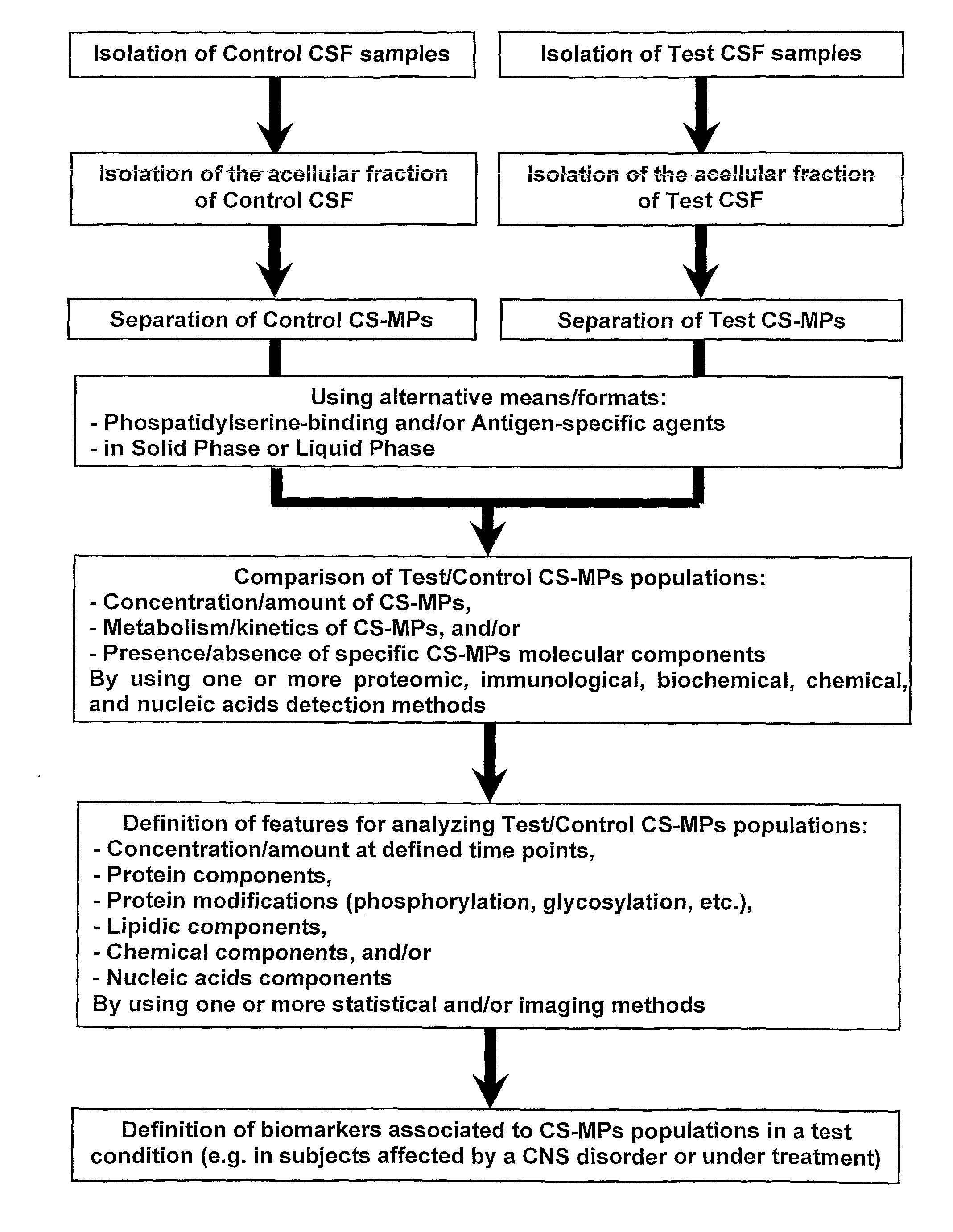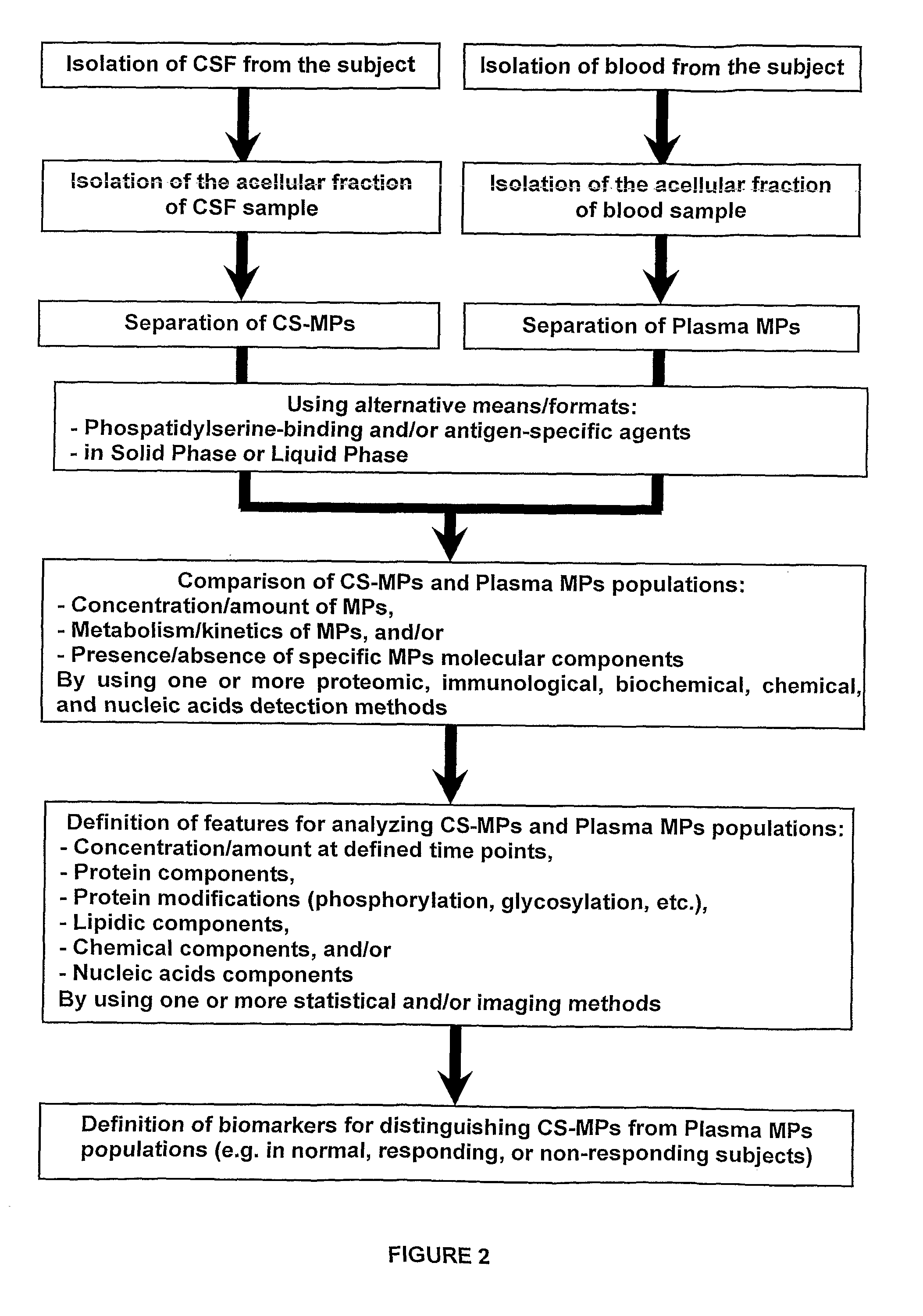Biological Components Within the Cerebrospinal Fluid
a technology of cerebrospinal fluid and biological components, applied in the field of biological components within the cerebrospinal fluid, can solve the problems of virtually impossible detection of csf-borne mps, unable to validate mps, and a considerable challenge in the development of disease-modifying therapies
- Summary
- Abstract
- Description
- Claims
- Application Information
AI Technical Summary
Benefits of technology
Problems solved by technology
Method used
Image
Examples
example 1
Quantification of Rat CS-MPs Compared to Plasma MPs
Materials & Methods
Isolation of Rat CSF
[0066]Male Sprague-Dawley rats (225-250 g, CERJ, France) were anesthetized with pentobarbital (55 mg / kg) and positioned in a stereotaxic frame. The rat head was flexed downward at approximately 45 degrees, a depressible surface with the appearance of a rhomb between occipital protuberances and the spine of the atlas becomes visible. The 25 G needle was punctured into the cisterna magna for CSF collection without making any incision at this region. The blunt end of the needle was inserted into a 10 in. length of PE-50 tubing and other end of the tubing was connected to a collection syringe (Hamilton, 100 μl). The non-blood contaminated sample (100 μl) was drawn into the syringe by simple aspiration. Samples with blood cell contaminations were discarded. A sample was centrifuged at 13,000 g for 2 minutes and the resulting supernatant was subsequently snap-frozen in polypropylene tubes. Samples we...
example 2
Quantification of MPs Produced in Cell Culture Conditions
Materials & Methods
Cell Culture Protocols
[0077]The human neuronal cell line SH-SY5Y (ATCC CRL-2266) was cultured in MEM / Ham's F12 medium (1:1) supplemented with 10% foetal bovine serum. Cells were seeded at 55,000 cells / cm2. Cell differentiation was induced by adding 9-cis retinoic acid (5 μM) for 5 days directly to complete culture medium. After 5 days, medium was replaced with complete medium supplemented with BDNF (50 ng / ml) for additional 5 days. At the end of the differentiation protocol, cells were rinsed with serum-free medium and then treated for 24 hours with complete medium containing Staurosporine (100 and 500 nM; Sigma, France) or vehicle (DMSO 0.1%).
MPs Quantification
[0078]At the end of the treatment, cell supernatants were collected and spun down for 15 minutes at 1,500 g at room temperature. MPs were then isolated by ultracentrifugation at 30,000 g for 45 minutes at room temperature. At this speed, both exosomes...
example 3
Analysis of MP Signature in Human CSF Samples
Materials & Methods
Isolation and Quantification of Human CS-MPs
[0091]The CSF samples were taken for diagnostic purpose from adult patients in medical institution by a lumbar puncture according to a standard procedure. Scientific use of CSF samples was approved by the local Ethics Committee and all patients gave a written informed consent for the diagnostic procedure. No traumatic signs were detected in all the patients.
[0092]50 to 300 μL of CSF was collected from each subject. CS-MPs were obtained after two sequential centrifugations. first at 1,500 g for 15 minutes at room temperature. The supernatant was then carefully removed and transferred to a new tube. The second centrifugation was performed at 13,000 g for 2 minutes at room temperature. Again, the supernatant was carefully transferred into a new tube and snap-frozen using liquid nitrogen. CS-MPs were stored at −80° C. until use.
[0093]CS-MPs quantifications were performed using flu...
PUM
| Property | Measurement | Unit |
|---|---|---|
| Diameter | aaaaa | aaaaa |
| Diameter | aaaaa | aaaaa |
| Nanoscale particle size | aaaaa | aaaaa |
Abstract
Description
Claims
Application Information
 Login to View More
Login to View More - R&D
- Intellectual Property
- Life Sciences
- Materials
- Tech Scout
- Unparalleled Data Quality
- Higher Quality Content
- 60% Fewer Hallucinations
Browse by: Latest US Patents, China's latest patents, Technical Efficacy Thesaurus, Application Domain, Technology Topic, Popular Technical Reports.
© 2025 PatSnap. All rights reserved.Legal|Privacy policy|Modern Slavery Act Transparency Statement|Sitemap|About US| Contact US: help@patsnap.com



